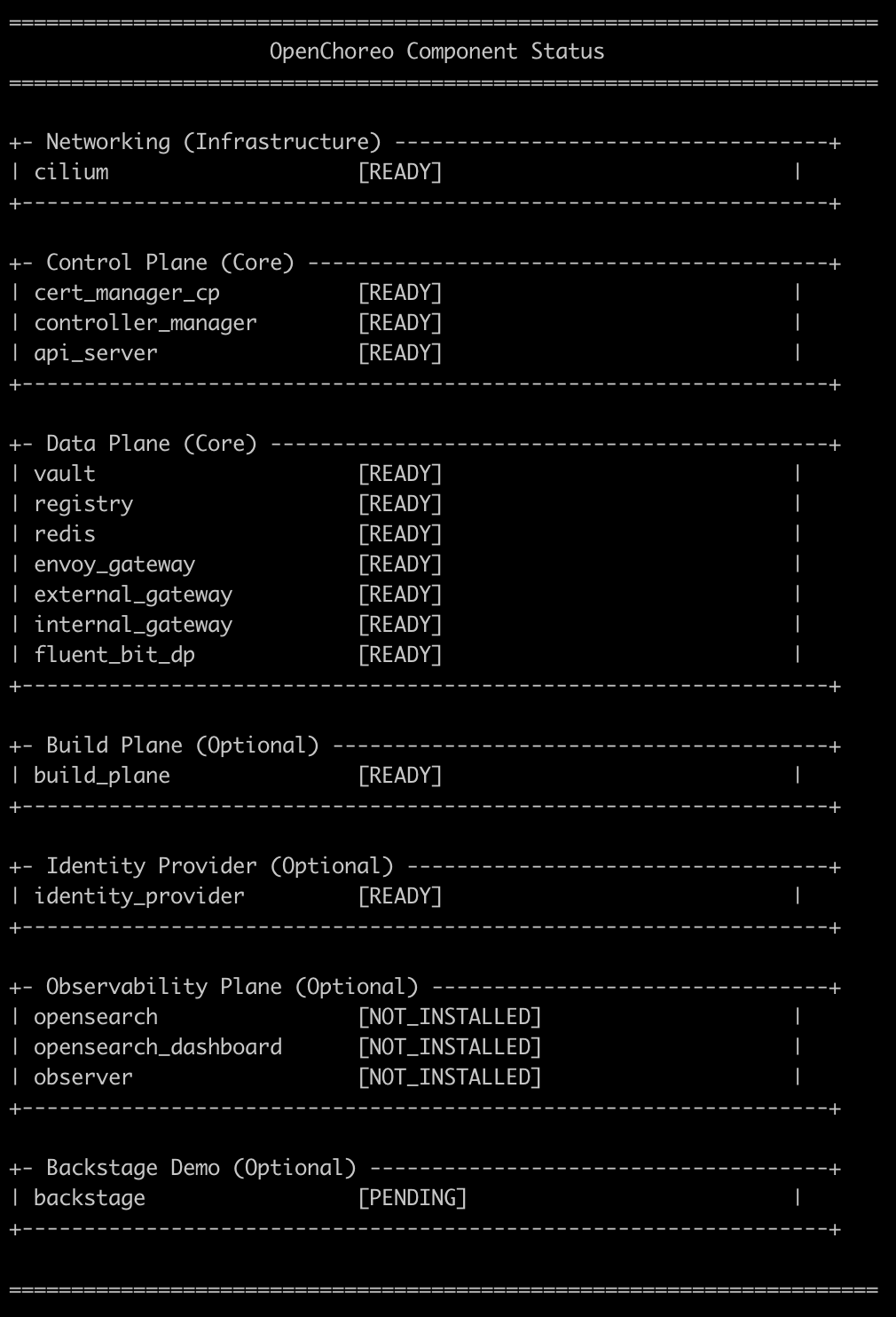Quick Start Guide
Follow this guide to quickly set up OpenChoreo in a local environment with Docker.
The setup uses a preconfigured Dev Container that includes all required dependencies for installation and cleanup.
Ensure the following before you begin:
- Docker (Engine 26.0+ recommended)
- Allocate at least 4 GB RAM and 2 CPUs.
- Mac users: Use Colima for best compatibility
colima start --vm-type=vz --vz-rosetta --cpu 2 --memory 4
- 5–10 minutes of setup time
If you encounter issues with Docker alternatives (Docker Desktop, Rancher Desktop, etc.), report them via GitHub.
Run the following command to start the dev container and open a terminal session within it:
docker run --rm -it --name openchoreo-quick-start \
--pull always \
-v /var/run/docker.sock:/var/run/docker.sock \
--network bridge \
-p 8443:8443 \
-p 7007:7007 \
ghcr.io/openchoreo/quick-start:v0.3.2
Inside the container, run the installation command:
./install.sh --openchoreo-version 0.3.2
This command performs the following:
- Creates a local KinD (Kubernetes-in-Docker) cluster
- Installs OpenChoreo and its dependencies using Helm charts.
The installation script is idempotent. You can rerun it safely if the process is interrupted.
When installation completes successfully, you see a summary of component statuses:

If any components remain in the pending state, wait a few minutes and run the following command to check their status:
./check-status.sh
The quickstart deployment includes a Backstage instance that acts as the developer portal for managing and visualizing OpenChoreo components. Once the backstage component is [READY], access it at:
🌐 Backstage Portal: http://localhost:7007
The Backstage portal provides:
- Cell Diagram: View deployed components and their relationships.
- Logs: Access build and runtime logs.
- Configure and Deploy: Manage configuration, deployment, and environment promotion
The portal automatically lists all components deployed through OpenChoreo, giving a unified view of the environment.
After setting up OpenChoreo in your Docker environment, deploy a sample web application by running:
./deploy_web_application.sh
When deployment completes, the output includes a message with the application URL:
✅ Endpoint is ready!
🌍 You can now access the Sample Web Application at: https://react-starter-development.choreoapps.localhost:8443
Understanding the Setup
Running the installation and deployment commands initializes OpenChoreo locally and deploys a sample web application. The following sections describe what occurs behind the scenes.
1. The Install Command
The installation process:
- Initializes a Dev Container with all required tools.
- Creates a KinD (Kubernetes-in-Docker) cluster in Docker.
- Installs the OpenChoreo IDP and dependencies using Helm charts.
Foundation Resources Created
The installation automatically provisions the following OpenChoreo abstractions:
- Organization
- Data Plane
- Build Plane
- Environments (e.g., Development, Staging, Production)
- Deployment Pipeline
- Project
View these resources using the following commands:
kubectl get organizations
kubectl get dataplanes
kubectl get environments
kubectl get projects
View details for a specific resource:
kubectl get project default -oyaml
2. Deploy Command
The deployment script creates:
- A sample Web Application Component
- The corresponding Deployment resource
List deployed components:
kubectl get components
Explore more examples in the Samples directory or in /samples inside the Dev Container.
When running samples in the Dev Container, you don’t need to expose the OpenChoreo Gateway manually; it’s already available on port 8443 of the host machine.
After completing your work, choose one of the following options:
- Exit and return later: Exit the Dev Container to resume work later:
exit - Full cleanup: Remove all resources and restore a clean environment:
./uninstall.sh
exit
This completes the setup and teardown process for OpenChoreo.
Troubleshooting
Docker Resource Constraints
If installation fails, confirm Docker has sufficient resources:
docker run --rm alpine:latest sh -c "echo 'Memory:'; free -h; echo; echo 'CPU Cores:'; nproc"
Ensure at least 4 GB RAM and 2 CPU cores are allocated.
Port Access Issues (Backstage and External Gateway)
If you're unable to access:
- Backstage at
localhost:7007 - External Gateway at port
8443
Verify that socat processes are running inside the Dev Container:
ps aux | grep socat
socat handles port forwarding between the container and the host machine. If these processes are not running, re-run the installation command:
./install.sh --openchoreo-version 0.3.2
You have now set up OpenChoreo locally using a preconfigured environment, deployed a sample web application, and learned how to inspect, manage, and clean up the setup. This environment serves as a reproducible baseline for testing and evaluating OpenChoreo components and workflows.